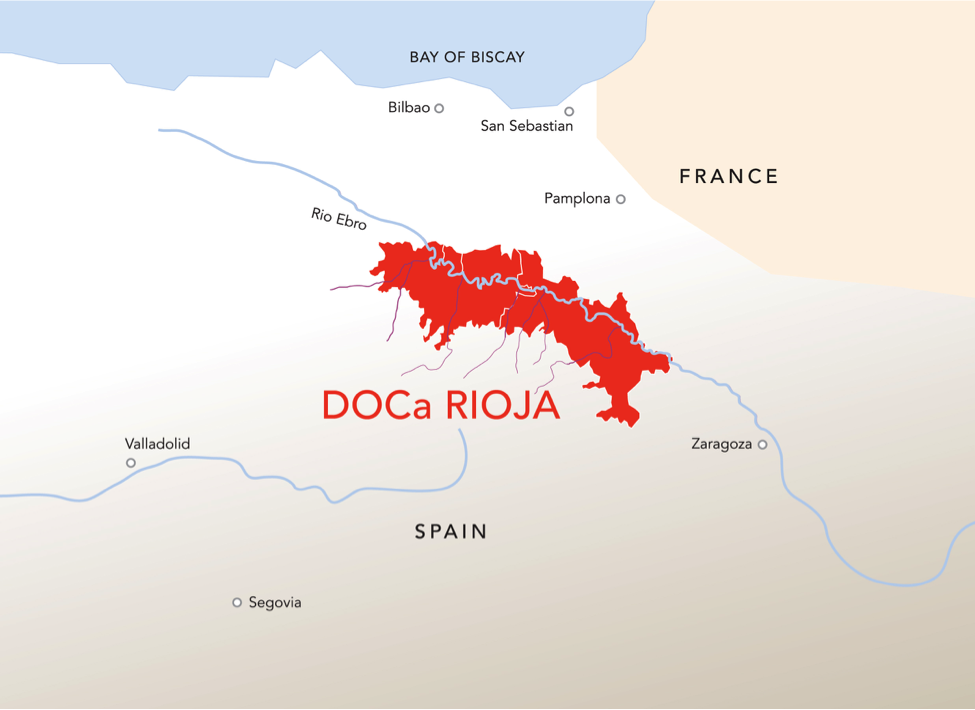
If you’re not familiar with Spanish wines, Rioja is a great place to start. It’s located in north-central Spain, and about 90% of its production is red wine. Rioja red wines are typically blends of several grapes, but Tempranillo predominates. There are also some nice whites and rosés, but that’s a topic for another day.
Rioja is sometimes referred to as “Spain’s Bordeaux” (with good reason, as many Bordeaux winemakers moved here in the late 19th century when their vineyards were decimated by disease and an insect called phylloxera). Some of Spain’s great wines are made here, but there are also good values to be found.
Let’s start with a teaser – our wine of the week is from Rioja, sells for about $18 retail, and in 2017 was named by Wine Spectator magazine as number 19 on its list of the top 100 wines. But, before we start tasting, here’s a little more background on Rioja.
Rioja is one of the top Spanish wine quality regions. It's one of two regions (the other is Priorat) designated as “DOCa” (Denominación de Origen Calificada). What that means is that the wines must comply with higher quality standards than Spain’s 67 “DO” (Denominaciónes de Origen) appellations. (There is one higher designation called “Vino de Pago” or “estate wine.”)
There are four classifications based on how long the wine has been aged. These classifications are not necessarily an indication of quality, although Riservas and Gran Riservas are typically good quality wines. The color of a Rioja wine label (note colors below) typically provides an easy identification of the classification, although use of this color scheme is voluntary:
- Rioja. These are young wines with little or no oak aging. They have very mild tannins, are full-bodied, very fruity and tend to have subtle spicy notes. These wines are inexpensive, and pair well with simple, spicy foods – think turkey sausage, buffalo wings or a ham panini.
- Crianza. These wines are aged at least one year in oak, plus an additional year in the bottle before release. They have soft tannins, good acidity and are fruity (notes of cherries and strawberries), with some spice. Crianzas pair well with anything with meat and tomato sauce, such as pasta or even a burger with ketchup. They’re also good with manchego cheese, prime rib and grilled pork chops. Beware of “bargain”priced crianzas, however, as these tend to be disappointing.
- Riserva. These are made only in exceptional years, and are aged at least one year in oak (typically two) plus an additional two years in bottle. These have earthier aromas and more subdued fruit than the crianza. They are spicy, full-bodied wines, and probably the best value Riojas. Because they are aged longer, they have firm tannins that pair well with a sirloin or ribeye, roasted lamb, or even some good Texas BBQ. (Hint: our wine of the week is a Riserva).
- Gran Riserva. These also are made only in exceptional years, and are aged a minimum of two years in oak and three years in bottle. They are complex wines,with subtle spice, soft fruit and notes of leather and mushrooms. They are lighter in color than the Riserva, and light- to medium-bodied. They are also good values. Think of a Gran Riserva to accompany duck or pheasant or just plain sipping.
Rioja reds are generally aged in oak longer that most regions in the world. The Riservas and Grand Riservas can be cellared for decades. But, a hallmark of Rioja wines is that they are ready for consumption when released.
And now, back to our wine of the week. It’s a 2012 Marqués de Cáceres Riserva. This wine is 85% Tempranillo, 10% Garnacha and 5% Graciano. It is a deep red, dense wine with dark red fruit, vanilla and spice notes, with a touch of earthiness. The tannins are firm but not overpowering. This wine paired great with a ribeye.
- If you can’t find the 2012, look for the 2014 (released in July 2018). The 2013 vintage was mediocre, so the winery did not produce a riserva.
- You can also step up to Marqués de Cáceres Gran Riserva for about $25 retail.
Other good Rioja producers. It’s worth experimenting with several producers, as each has its own style. The traditional Rioja style involves aging the wine for a long period in older oak, producing a mellow, earthy wine. For example, Muga and R. Lopez de Heredia produce traditional style wines. The modern style uses riper grapes and shorter aging in new oak barrels, thereby producing a fruitier, oakier wine. Marques de Riscal produces excellent wines in both traditional and modern styles. Other good producers are La Rioja Alta and Baron de Ley.
